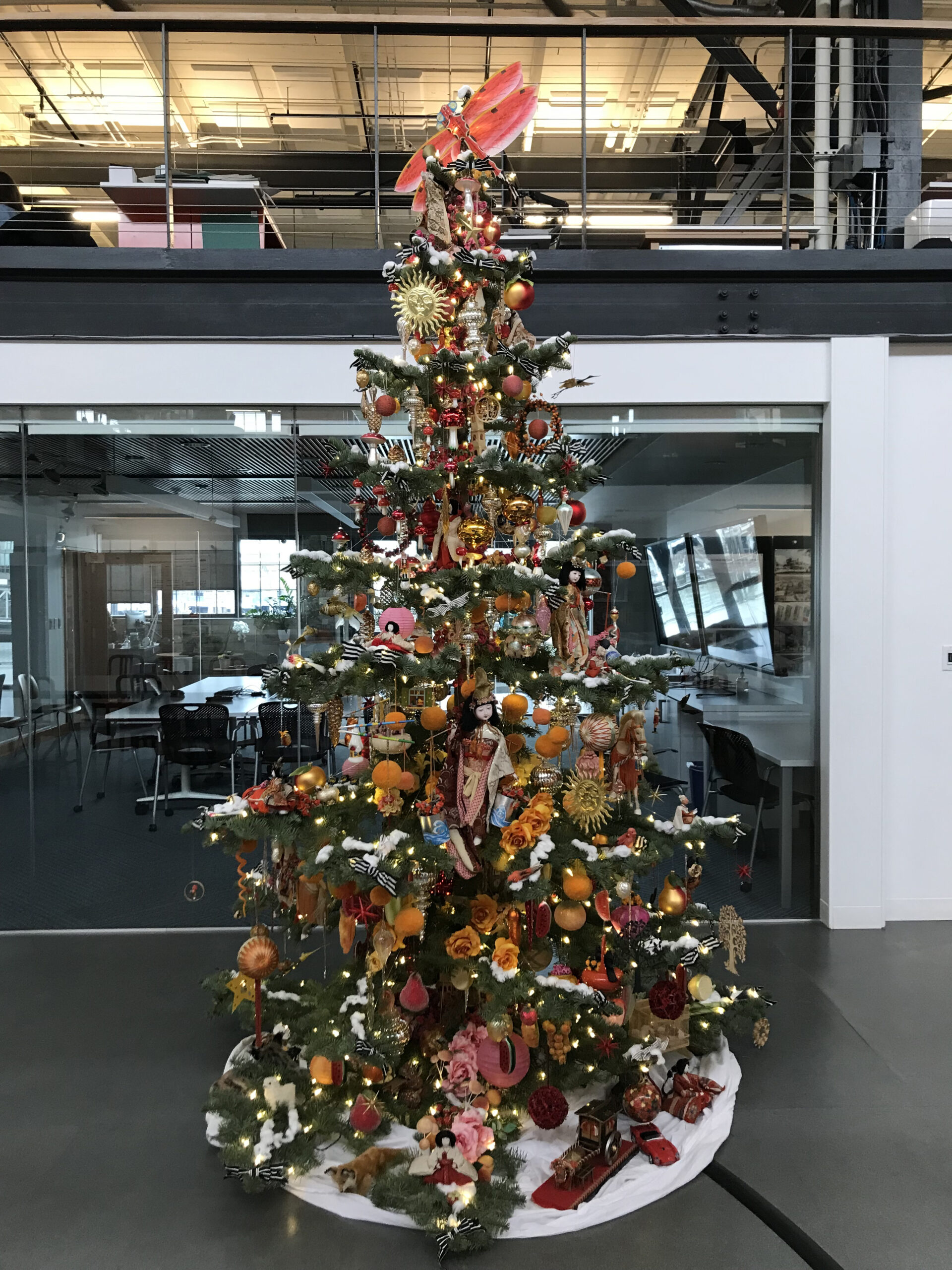EHDD’s Christmas Tree: More is More

My beau ideal of a Christmas tree is the Angel Tree in the Metropolitan Museum of Art; but as I can’t have that, I create trees that are dense with other objects I love. This is my sixteenth tree, as I’ve been decorating trees at EHDD every other holiday season since 1987.
The Tree
I decorate natural trees, with natural shapes and scent. I avoid trees that have been shaped into smooth cones by chainsaws, ruining the ends of their branches.
Dense ornamentation requires a fairly open tree with clear, tall tiers and strong branches, such as our Silver Tip (from East Bay Nursery in Berkeley) or a Noble Fir, which tends to be denser. I prune some minor or spindly branches so that one can see and hang ornaments to the trunk. A few big holes or gaps in the foliage are necessary – they allow room for the largest ornaments, which anchor the composition. If the natural gaps aren’t large enough, one can prune to enlarge them.
Crooked trunks can be both visually interesting and useful; if the crook is at the top, as in this tree, that allows a large top ornament to be more centered on the main trunk below.
Clustering and Variation
The biggest and the best ornaments are anchors around which the rest of the ornaments are arranged, to reinforce or accent the anchor ornaments by clusters of color, texture, and kind. I group similar ornaments of different sizes, such as the silver mercury glass spindles, or several of the same ornaments at different heights, avoiding uniformity.
The tall spaces between tiers of branches allow this variation in height, avoiding the ‘laundry line’ of ornaments hung by the same length of the hook. Instead of hooks, I hang ornaments with fishing line, so that the height is completely adjustable – sometimes extending down more than a tier.
Ornaments can be placed or tied on top of branches, not just hung from them, and clustered around the trunk. Bunches of small paper roses are especially useful for twining around the trunk — masses of color at the center of the tree, hiding the dense support structure of the fishing line.
Atypical Ornaments
Almost anything can be used as an ornament if it is beautiful, light-weight, well-made, well-colored, and not too valuable to risk. My atypical ornaments include many Japanese dolls, sake pots, and tamari balls; Chinese kites, lanterns, pearls, and wheat straw model buildings; paper and fabric roses, toys, children’s paintbrushes, swizzle sticks, cotton snow, and ribbons.
Big paper cut-outs, such as the gold suns on this tree, are very light-weight and can be hung on the very ends of branches. This is especially useful when visual mass is needed where a heavier ornament wouldn’t work.
Very heavy ornaments such as the Japanese dolls and horses are possible when supported by the trunk, either directly tied to it, or hung where branches are guyed back to the trunk.
Shades and Hues
Orange, yellow, pink, white, frosty light blue, silver, and gold all show well on a tree.
Classic Christmas red is similar in value (darkness) to green tree needles, so I prefer it for only accents or a few clusters, rather than the main color.
Black can be an effective accent color; the black-and-white striped bows are ‘palate cleansers’, in contrast to the many other colors. Masses of black are especially visible when eclipsing bright colors behind them.
I even include some ornaments that have “less-than-ideal colors”, i.e. the grays of the Star Wars starships, chasing each other around the bottom tier. But, in this case, a large black tamari ball stands in for the Death Star.
Some Assembly Required
A tall and densely decorated tree requires organization and preparation. After the tree is pruned and the lights installed, I guy all the branches back to the trunk with the fishing line, so that they can support the significant weight without sagging. I use 30 lb. fishing line for the guying and for hanging the heaviest ornaments, and 15 or 8 lb. for lighter work.
Before hanging, I unpack all the ornaments and lay them where I can see and select them as needed. Then, in order, I compose and install:
- The very top-heavy or central ornaments (tall ladder work)
- Anything tied to the trunk, including paper roses
- Ribbons at the ends of branches and strings of pearls
- Any remaining tall ladder work, as the lower branches have ornaments that might be damaged by the ladder.
- The remaining ‘anchor’ ornaments
- Clusters of ornaments
- Lowest hung ornaments
- Ornaments tied to the tops of branches (such as Japanese Hina dolls)
- Additional roses on trunk and branches as needed to reinforce clusters of color
- Skirt and toys on the floor
Safety First
I recommend LED lights for their safety (even if older lights are still working), and a solid tree stand. For a large tree such as this one, a welded stand with a large integral water reservoir is ideal.
In San Francisco commercial spaces, see the San Francisco Fire Department Information Bulletin regarding ‘Use of Christmas Trees in Regulated Occupancies’. Fire-retardant treatment of natural trees, and/or fire sprinklers, may be required.

